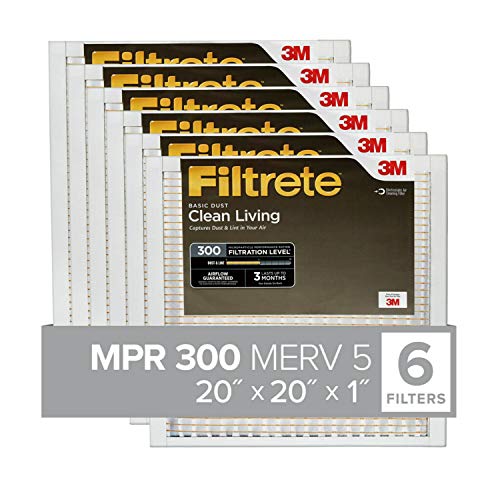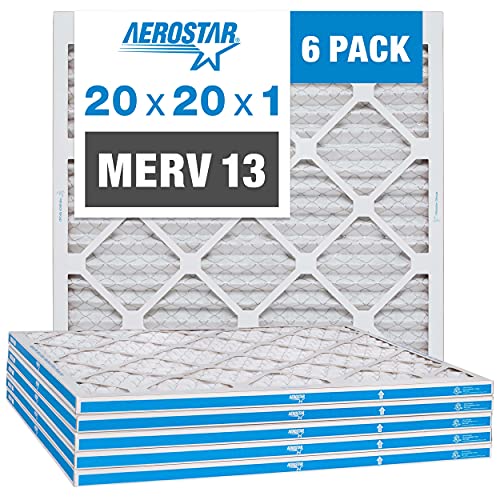The Best Furnace Filters for 2022
/Best Furnace Filters
Disclaimer: As an Amazon Associate I earn from qualifying purchases. There are affiliate links in this post. This means that at no cost to you, I will receive a commission if you purchase through my link. I will only ever promote the products and services that I trust and 100% recommend. You may read my full disclosure policy for more information. Thank you for supporting my business in this way.
Regularly replacing the filter in your home is an essential maintenance item to keep the furnace operating effectively and efficiently. The good news is that as long as you select the right size, the installation is a quick and easy process, so read on to learn more.
To help you select which one is best for you, I have outlined what features to look out for along with a list of the best furnace filters currently available.
UPDATED: April 11, 2022.
MY TOP PICK:
If you are looking for the best overall, I recommend the AIRx HEALTH Filter because it features the highest rating for residential use (MERV 13), is available in a range of sizes and is made in the USA.
It's no secret that today's tightly built homes can trap dust, allergens, and many more potentially hazardous contaminants. According to the EPA on the Importance of Indoor Air Quality, “indoor concentrations of some pollutants have increased in recent decades due to energy-efficient building construction (when it lacks sufficient mechanical ventilation to ensure adequate air exchange) and increased use of synthetic building materials, furnishings, personal care products, pesticides, and household cleaners”.
How Often Does A Furnace Filter Need To Be Replaced?
Replacement timeline recommendations for furnace filters will vary based on a number of factors. These include the amount of use, environmental factors, type of filter, and pets. However, the general advice is to change your replaceable filter every three to six months.
Also, each manufacturer will have its own timeline so check the filter specifications. Some smart thermostats like Nest will provide a reminder for when it is time to replace the filter.
Filter Sizes
Be certain to measure the filters you are replacing or your filter boot to make sure it's an exact match. The length, width, and thickness of your existing filter will be also be printed on the sides. Use these values for reference when ordering new filters.
Nominal Size vs. Actual Size
There are two filter measurements to be aware of, the “nominal size” and the “actual size”. This is important if you don’t have a current filter to simply take the numbers from and are going off the furnace slot dimensions.
Similar to how a 2x4 stud is not actually 2 inches by 4 inches, the nominal size of a filter does not match the actual dimensions. For example, a filter with a nominal size of 20” x 20” x 1” may have an actual size of 19 3/4" x 19 3/4" x 3/4".
Filter Thickness
The length and width dimensions of the system’s filter compartment generally do not impact efficiency. The thickness of a filter does, however, impact its efficiency and ability to remove contaminants. There are two standard filter thicknesses, 1" and 4". If your system uses a 1” filter, a 4” filter will not be able to fit the existing cabinet.
RELATED: The 10 Best Whole House Water Filters
MERV Rating
Minimum Efficiency Reporting Value (MERV) is a standard that rates the overall effectiveness of air filters. A high MERV rating means a finer filter, which removes more airborne contaminants and dust particles.
The typical residential home air system can remove airborne contaminants with a filter rated between MERV 6-13. Both 1” and 4” filters are available with a range of MERV ratings.
See also: A Good SEER Rating: Defined
MPR Rating
The Micro-particle Performance Rating is a system developed by 3M that ranges from MPR 300 to 1900. It rates the manufacturer’s filters and their ability to capture airborne particles smaller than 1 micron.
Replace your furnace filters regularly to improve indoor air quality while lowering your energy bill and keeping your home clean.
Washable vs. Disposable
The majority of filters available today are disposable, meaning when it reaches the end of its lifecycle it is thrown away. Another option is to go with a washable filter. Instead of throwing it away it can be washed and used again. This helps to lower waste and reduce costs in the long run. However, washable filters typically can’t match the particle removing performance of a disposable (at least for now). In addition, it does require the hassle of having to manually clean the filter.
Installation
Replacing a filter is a very straightforward process. Depending on your HVAC set up the filter will be located within a slot in the furnace or mounted within a return-air vent, for example in the ceiling. The main point to note is the direction of the airflow. This direction needs to correspond to the flow arrows on the filter when installing it.
Check out this brief video on how to change your furnace filter:
Now, on to the individual products. I’ve compiled a list of the top models available from well-known manufacturers including AIRx, Honeywell, Filtrete, and more. Each unit has been assigned a key feature that makes it particularly noteworthy and has been broken down according to its essential functions to help you make an informed selection.
So here is my list of The Best Furnace Filters for 2022.
Enjoy!
Best Overall: AIRx Health 1" MERV 13 Furnace Filters
The AIRx Health offers the highest rating for residential use: MERV 13.
Offers the ability to essentially turn an air conditioning and heating system into a whole house air cleaner, by reducing respiratory irritants, smog, bacteria, viruses, and mold throughout the home.
Traps and locks ultrafine particles to improve the indoor air quality of the home.
Reduces small particles such as smog and respiratory irritants, but also protects against allergens, dust, and debris.
Offers protection for heating and air conditioning equipment from clogging with dust, affording optimal operating efficiency, better airflow, and reduced energy and maintenance costs.
Features pleats that provide efficient airflow and reduced energy costs in addition to effective particle holding capabilities.
Best Long Life: Filtrete Micro Allergen 4" Furnace Filters
The Filtrete Micro Allergen filters are designed to be replaced every 6 to 12 months.
Purifies air by capturing a high percentage of household air particles, including those at 0.3 microns.
Works to maintain airflow which reduces the load on the HVAC system, saving envergy.
Features electro-static technology to remove household dust, lint, dust-mite debris, mold spores, pollen, pet dander, and smog.
Replaces Honeywell, TrionAirBear, Bryant , Carrier, and Lennox, brand filters.
Replaces 16 x 25 x 5 inch filters with the same actual size.
Designed with Filtrete Brand 3-in-1 technology from 3M to pull in and trap unwanted air particles while letting clean air flow through.
Best 4” Option: Honeywell FC100A1037 Ultra Efficiency Furnace Filters
The Honeywell FC100A1037 features a Minimum Efficiency Reporting Value (MERV) rating of 10.
Features a filter life of three to six months.
Offers the ability to trap particles as small as 0.3 microns.
Designed to removed pollen, dust, pet dander, and mold spores from the air.
Designed to fit Honeywell and similar media air cleaners.
Works with Honeywell 20X25, 25X20, 25X22 F100, and F200 Media Air Cleaners, SpaceGard 2200.
Best Value: FilterBuy 1" Furnace Filters
The FilterBuy 1" filters feature a MERV rating of 8.
Offers the ability to filter out dust mites and other allergens.
Removes lint and dust, dust mite debris, pollen, and mold spores.
Designed to last up to three months.
Best for Allergies: AIRx ALLERGY 1" Furnace Filters
The AIRx ALLERGY 1" filters feature a MERV 11 rating designed for allergen protection.
Offers the ability to trap pollen, mold, pet dander, smoke particles, and more.
Equipped with higher than the average number of pleats.
Features an energy-efficient design that captures airborne particles.
Features a nominal dimension of 16” x 20” x 1”.
Made in the USA.
Best Premium Option: Lennox X6673 4" Furnace Filters
The Lennox X6673 filters feature a MERV 11 rating.
Filters out contaminants down to just 0.3 microns.
Removes airborne contaminants such as dust mites, pollen, mold spores, and pet dander
Equipped with a synthetic media that has a large surface area to minimize the air resistance while still effectively removing contaminants.
Recommended replacement cycle is every 6 months under normal conditions.
Features a nominal size of 20” x 25” x 5” and actual size of 19-3/4" X 24-3/4" X 4-3/8"
Best for High Velocity HVAC: Filtrete Clean Living 1" Furnace Filters
The Filtrete Clean Living filters are designed for high-velocity heating and cooling systems.
Equipped with electrostatically charged fibers that remove airborne contaminants such as pollen, household dust, and lint.
Features a 300 MPR Performance Rating (MERV 5).
Recommended to be replaced every three months.
Designed for residential use only.
Best Washable: Trophy Air Electrostatic 1" Furnace Filter
The Trophy Air Electrostatic filter features a washable design that is optimized to reduce air resistance.
Designed to be reused to reduce waste and save money over time when compared to disposable filters.
Constructed with four layers of high-grade aluminum and two layers of electrostatic media.
Features a nominal size of 16” x 20” x 1”.
Made in the United States.
Best Budget Option: Aerostar 1" Furnace Filters
The Aerostar 1" filters feature a best-in-class MERV 13 rating.
Filters particles including lint, dust mites, spores, pollen, pet dander, dust, and more.
Constructed from synthetic electrostatic media to reduce air resistance for efficiency.
Made in the U.S.A.
Recommended change frequency is 60 to 90 days but increase frequency to 30 days during peak summer and winter months.
Features a nominal size of 20” x 20” x 1” and actual size of 19 3/4"x 19 3/4" x 3/4".
Best for Honeywell Units: Nordic Pure 4" Furnace Filters
The Nordic Pure filters are designed as replacements specifically for Honeywell units.
Features a MERV 12 rating.
Works to reduce pollen, pet dander, dust, mold, and more.
Features a nominal dimension of 20” x 25” x 5” and an actual dimension of 19 7/8” x 24 7/8” x 4 3/8”.
Designed as replacements for Honeywell 203720, FC35A1027, FC100A1037 and FC200E1037.
I hope this list of the best furnace filters was helpful.
If you think I left out one that is important or have a suggestion for a future article, let me know in the comments below.
Brandon Hubbard, AIA, NCARB, LEED AP BD+C












